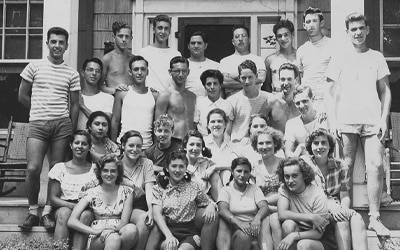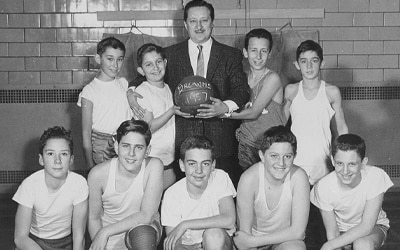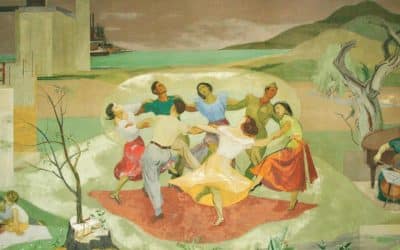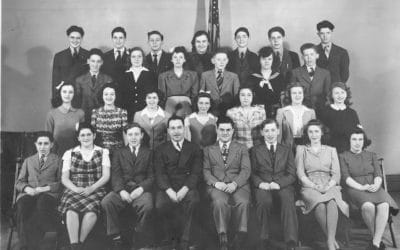Agencies / Jewish Community Center
Historical Overview of the Jewish Community Center of Greater Buffalo and Summer Camps
Forerunners to the Jewish Community Center of Greater Buffalo
The Jewish Community Center began as an Americanizing institution in 1891 by the Sisterhood of Zion, a women’s community service group formed to aid Jewish immigrants from Eastern Europe. Associated with Temple Beth Zion, the women’s group rented a house on Walnut Street to serve as a “place where Jews of all ages could come together for various cultural, recreational and educational pursuits.” It was staffed by women of the Sisterhood of Zion, and the Daughters of the Star, another Temple Beth Zion group, who raised funds for the house. Three years later, the structure was too small and the group moved to Spring Street, into a building they named Zion House, only to relocate again in 1896, to a new building at 456 Jefferson Avenue also known as Zion House. Within the decade, more space was needed and with the aid of the forerunner to the Jewish Federation of Buffalo, a purpose-built facility was built as the Jewish Community Building (JCB). Located at 406 Jefferson Avenue, close to the old building, this facility emerged as a community “center,” replacing the old settlement style organization. Now a fully integrated community resource, it rapidly became a community hub providing numerous programs, activities and meeting spaces for a diverse range of groups. Informal groups, fellowships, scouts, unaffiliated clubs separated along gender lines.
Another organization, the Jewish Young Men’s Association used the JCC building as its’ meeting place for several years as well. In 1924, the JYMA changed its’ name to the Young Men’s Hebrew Association (YMHA). A separate women’s group, the Young Women’s Hebrew Association also met at the Jewish Community Building. Both of these men’s and women’s clubs went through expansions as well as periods of inactivity, but after reorganizing, moved to their own home on Linwood Avenue in 1937. In 1945, their building was demolished by fire on New Year’s Day. This event coincided with location problems with the Jewish Community Building (JGB). In 1943, the JCB had to vacate its premises at 406 Jefferson, as part of the Willert Park Government Housing Project, and the former JCB building became a community building for the housing project’s residents. As a result, the Jewish Community “Building” had had a series of temporary quarters in the Talmud Torah building on Hickory Street, followed by a more permanent home in a converted factory on Monroe Street where it formerly relocated in 1944. The Linwood Avenue fire and the destruction of the “Y” event coupled with the increasingly cramped JCB facilities in the Monroe Building led to the formation of a special community-wide committee. In 1945, the Board of Directors of the JCB and the “Y” merged under a single corporation, as the Jewish Center of Buffalo (JCC).
Documents
The Jewish Center
From 1945, with a combination of ongoing and expanding Jewish Center activities and the addition of “Y” activities too, space became an increasingly pressing issue at the Monroe Building. In March of 1947, as a temporary solution, the Jewish Center administrative offices joined the Jewish Federation and the Jewish Community Service Society (a forerunner to the Jewish Family Service) at the Root Building on W. Chippewa.
Still without a dedicated home, the Jewish Center ran programs at Monroe, and extension programs in area temples, public schools and other institutions. Increasingly the split programming and administrative sites, made general operations difficult, and when a lot on the corner of Delaware Avenue and Summer Street became available, it was purchased by the New Building Committee for construction.
Milton Milstein was hired as the architect to create a building that could serve multiple functions as a sports center, a convening space, a cultural arts venue, a community space with rooms for clubs and offices as well as a venue with child care facilities and an educational space for classes, and other programming. Funding for the building, known as the “Delaware Avenue JCC” came from the proceeds of the sale of the Monroe Street building and $500,000 in pledges by 1,500 families. The remainder of the funds came from a net capital fund grant from the Jewish Federation of Buffalo during the 1948-1951 campaigns.
Ground was broken at Delaware and Summer on April, 4, 1948 with hundreds in attendance including the Mayor of the City of Buffalo, Bernard J. Dowd. By November 21, the cornerstone of the Jewish Center of Buffalo at 787 Delaware Avenue was set in place inscribed with the words “Beth Am” (House of the People). The building had a distinct modernist aesthetic with a focus on glass, metal and brick a design that allowed for the addition of extra wings as funding allowed. Opening in the spring of 1949, the “Center” operated at near capacity from its outset. In the entrance lobby, (since restored in 2019), a mural of figures danced the hora against a backdrop of city and countryside. The mural was dedicated on January 18, 1950 and created by Lewis Rubenstein, a well-known time painter and former Temple Beth El member, with layered imagery. The hora (a Jewish folkdance) combined with a sapling growing out of the stump of an old tree was to symbolize the revitalization of contemporary postwar Jewish life in Buffalo as well as the establishment of the State of Israel.
Programs
From the 1950s, the Jewish Community Center place a strong emphasis on children and youth. Early Childhood programs, and care services alongside, family recreational activities at the center of Center activities expanded. With this stress, the investment in day and summer camping also expanded at Camp Lakeland and through the creation of a new Camp Centerland.
Camp Lakeland Counselors, 1947, MS 204, Jewish Community Center of Greater Buffalo and Summer Camps Records, 1915-2009. Permission of the University Archives, University at Buffalo, The State University of New York.
Jewish Fresh Air Camp and Camp Lakeland
Agencies /Jewish Community Center /Jewish Fresh Air Camp and Camp LakelandOverviewCamp Lakeland opened as the Jewish Fresh Air Camp in 1910 under the auspices of the Young Women’s Jewish Benevolent Society. In the earliest days of the camp, this all volunteer...
Centerland extension location, Beaver Island State Park, Grand Island, NY, c. 1943. Photograph created by Frederic Marschall. Courtesy of Getelle Rein.
Camp Centerland
Agencies / Jewish Community Center / Camp CenterlandOverviewCamp Centerland began as an extended summer option for young children at the Jewish Community Center known as Centerland. This program expanded in the period following World War II from a patchwork of day...
Within less than a decade and as a direct result of the population movement to the suburbs, a site for the construction of a suburban branch of the Jewish Center was purchased on North Bailey in the late 1950s. Soon after his hire as the new Executive Director, however, William Grossman delayed a decision on the North Bailey development until a comprehensive evaluation of all services had been completed in 1965. The need for a suburban site had been evident for almost a decade as Jewish population movements to the suburbs accelerated, but these relocation patterns spread across a broad arc that made any site chosen only suitable for some families, but not others. With an initial statement by the University at Buffalo that it would build in the suburbs near Millersport Highway in 1964, however, and with a separate Site Review Committee, the Jewish Center made the decision to sell the North Bailey property and to purchase fourteen acres of land on North Forest Road in 1967. With nearly fifty-five per cent of the Jewish population of Erie County residing in the suburbs, the space at the city location exhausted and extension programs over-subscribed, the need for a suburban location was proven, but raising funding for a major development was a significant philanthropic undertaking.
To address the delay in building a pool and the creation of women’s lockers at Delaware Avenue, fundraising focused on these more attainable goals. With a broader expansion ahead, however, the Center changed its’ name from the Jewish Center of Buffalo to the Jewish Center of Greater Buffalo in 1970. Gordon Gross, Richard Ament and Leonard Rochwager worked to secure the fundraising for the suburban center and John Laping was selected as architect. Ground-breaking ceremonies were held on October 15, 1972 and the cornerstone was laid on May 19, 1974, with the building completed in July 1974. In this original form, a sheltered courtyard area later became the site of the Holocaust Memorial Sculpture, dedicated on April 17, 1977. Designed by Tony Rosenthal, local lawyer Morris Mesch and Holocaust survivor, Rubin Literman, steered the fundraising committee for the costs of the artist and the fabrication of the panels and installation.
In the fall of 1983, the Center was the recipient of a gift of $1 million from Nathan Benderson and his family and in May 1984, the suburban building was renamed the Benderson Family Building. Five years later on May 22, 1989, the JCC held a mortgage burning ceremony. By 1993 the outdoor pool complex was completed and dedicated in the name of Shirley and William Grossman. In contrast to the expanding amenities of the suburban JCC, the downtown center faced several challenges in the 1990s as the building faced major age-related issues. In 1995 Ann Holland Cohn, a philanthropist and long-standing volunteer art teacher at the Center donated $1 million from the estate of her father, Henry Holland, for the upgrade and renovation of the aging Delaware Avenue building. Her gift encouraged others to give to the cause, including Nathan Benderson. In recognition of her leadership, the JCC building on Delaware Avenue was later named “Holland Family Building”. This rebirth of the Delaware Avenue Jewish Center significantly increased numbers of individuals and groups who used the building from the mid 1990s. Further renovation improvements began in 2008 and were completed in 2010.
These repairs and upgrades followed the proposed shutdown of the suburban JCC due to running costs. After an outpouring of concern for the proposed shuttering of the suburban Jewish Community Center, the board launched a task force led by Kevin Kulick. By 2008, a new $6 million plan called for the reduction of the suburban center’s footprint. This facilitated the doubling of available parking and the building of a new more accessible entrance facing North Forest Road. It relocated the Holocaust Memorial into a more prominent position and saw the downtown facility received its own $1 million face-lift that resulted in a new outdoor playground along Delaware Avenue and Summer Streets for its youth programs, an expanded fitness center and additional parking. The Benderson family committed $2 million, with additional gifts from others totaling another $1 million. By June 2012, the consolidation of several agencies under “one roof” enabled the Jewish Federation of Greater Buffalo, the Bureau of Jewish Education and the Foundation for Jewish Philanthropies to share space on the second floor. Beginning in 2018, a $4 million expansion at the Jewish Community Center at Delaware Avenue, created more space and upgraded areas with a renovated lower level, a new multi-purpose court and other new features. The expansion also added a new 1,800 ft indoor playground, a newly designed lobby area, and more. To find out more about the expansions, and the philanthropy that supported it, consult the 2016 to 2019 annual reports.
As a community space and a community venue
In connecting with other groups, Jewish and non-Jewish, and providing a community space for independent groups the Jewish Center maintain its long-standing tradition of being a Beth Am—a home of the people. Beginning in the 1950s several Jewish women’s organizations shared rented office space including Hadassah. The Bureau of Jewish Education and the Hebrew Benevolent Loan Association continued their associations for decades in the Center on Delaware and later in the suburban branch, along with Hadassah. Kadimah School of Buffalo held its earliest classes in the building. Temple Sinai rented space at the Center for their High Holiday services before their own sanctuary was erected. Temple Beth Zion initiated a long-standing agreement to hold services and utilize class room space for several years after a catastrophic fire destroyed its sanctuary in 1961.
Throughout the Jewish Community Center’s history it has a served as a convening space for community events and civic and community wide events remain a significant part of the public face of the Jewish Center. Historically, some of the earliest observances of Yom HaShoah were sponsored by the Jewish Center, as the “Warsaw Ghetto Memorial Service” arranged by a New Americans group of Holocaust survivors. Israeli Independence Day celebrations were a strong part of its programming from its opening. Protests at the plight of Soviet Jews were also coordinated by Jewish Center volunteers. Another volunteer event brought over 1000 volunteers, many from the Jewish Center to contribute their time and talents to participation in Israel Expo 1976. This two-year long planning process, culminated in a week-long festival focusing on Israeli culture and innovation, held to coincide with Yom Ha’azma’out (Independence Day) in May. If you have images from this event you can share, please contact us.
As a center open to the entire community, and with public programming offered to the entire community, the Jewish Center has provided theater, cultural, music and arts experiences since its inception. One of the more unusual events took place in 1972 in cooperation with the Creative Music Associates at the University at Buffalo. Funded by the State Council of the Arts and Creative Associates, an avant-garde composition by Max Neuhaus entitled “Music Whistle” played under water in the Center swimming pool as attendees jumped into the pool to listen. If you have images from this event, or memories of it, that you can share, please contact us.
New innovative civic observances continue to evolve for the entire community, Jewish and non-Jewish. The first Great Buffalo Jewbilee to celebrate Buffalo Jewish food and culture took place on August 15, 2018 as a joint venture of the Jewish Community Center, the Buffalo Jewish Federation and Temple Beth Zion utilizing the venues of both institutions.
Combining forces and partnering with other institutions is a long-standing tradition of the Jewish Center, especially in areas allied to social work. The Jewish Center is often one of the first agencies in concert with Jewish Family Service (and its’ forerunners) to identify societal trends and particular needs of its members and participants, and devising programming to meet those needs. This has resulted in specialized elder care-based programs, initiatives for New Americans, intermarried couples and one parent families, as well as youth programming for teenagers around social issues.
The Jewish Center has also integrated distinct organizations as special programs and projects or as independent organizations allied to its broader mission. The longest partnership of this type is the Jewish Book Fair that began in 1967 and provided a venue for Buffalonians to meet authors and hear readings and lectures. Now known as the JCC Books and Arts Fair it continues to expand offering programming over several months. The annual Jewish Film Festival, since renamed the Buffalo International Jewish Film Festival was founded in 1985 and is the third longest running film festival of its kind in North America. It partners with local theaters to show films to the community over several weeks each year. Since 2002, the Jewish Repertory Theatre of Western New York co-founded by Saul Elkin and David Bunis has produced professional theater in various theatre venues, but since a new purpose-built theatre was dedicated during its 9th season has made its home in the Maxine and Robert Seller Theatre at the Benderson JCC Building.
At its opening in 1949, the Jewish Center sought to provide a unifying place for people of all ages and economic backgrounds to experience social, cultural, educational, and recreational interests in a welcoming and inclusive environment where participation could take place on multiple levels. The modern Jewish Community Centers continue as centers open to all offering programming that make Jewish values and traditions relevant to contemporary life in the United States.
Gallery
For More Images
Click to visit New York Heritage, Jewish Buffalo Image collection: Jewish Community Center
Israel Information Desk, Jewish Community Center, 787 Delaware Ave, Buffalo, NY 14209. Courtesy of Nancy Schiller.
Israel Information Desk, Jewish Community Center
Sunday Religious School Class, Jewish Community Building, 1940s. Courtesy of Leon Komm.
Sunday Religious School Class, Jewish Community Building, 1940s
Zion House, Clipping, Buffalo Courier Express, c. 1902.
Zion House
Omega Kappa Zeta Sweater, created by Harold "Polly" Polakov, 1940s. Photograph created by Izon Productions-Don Dannecker, 2013. Permission of Foundation for Jewish Philanthropies.
Omega Kappa Zeta Sweater
Jewish Community Building, Boy Scout Troop 47, 1940s. Photograph created by Elizabeth Kahle. Courtesy of Harvey Schiller.
Boy Scouts
Jewish Community Center Benderson Building. Photograph created by Don Dannecker-Izon Productions, 2013. Permission of the Foundation for Jewish Philanthropies.
Jewish Community Center Benderson Building
Jewish Community Center Benderson Building. Photograph created by Don Dannecker-Izon Productions, 2013. Permission of the Foundation for Jewish Philanthropies.
Jewish Community Center Benderson Building
PALS Fraternity, Jewish Community Center, Courtesy of Leonard Katz, MD.
PALS Fraternity
Y.W.H.A. Purim Party at the Jewish Community Building, c. 1930s. Courtesy of Getelle Rein.
Young Women’s Hebrew Association
Ground breaking at the new Jewish Community Center, 1947. Samuel Markel with shovel; Cecil B. Weiner is woman on right. Image created by Frederic Marschall. MS 204, Jewish Community Center of Greater Buffalo and Summer Camps Records, 1915-2009. Permission of the University Archives, University at Buffalo, The State University of New York.
Ground breaking at the new Jewish Community Center, 1947
Historical Plaque formerly mounted at the Jewish Community Center listing Jewish Community Center Presidents, and their office terms. Photograph created by Don Dannecker-Izon Productions, 2017. Permission of the Foundation for Jewish Philanthropies.
Historical Plaque formerly mounted at the Jewish Community Center
Browns Boys Basket Ball team at the Jewish Community Center, 1957. Front row kneeling, from left to right: Unidentified; Barry Warner; Alan Lewis; Elliot Fixler; Marc Lippman. Back Row, standing from Left to right: Rick Falk; Alan Cheskin; Dave Cheskin; David Treger; Alec Cohen. Photograph created by Frederic Marschall. MS 204, Jewish Community Center of Greater Buffalo and Summer Camps Records, 1915-2009. Permission of the University Archives, University at Buffalo, The State University of New York.
Browns Boys Basket Ball team at the Jewish Community Center, 1957
Mural by Lewis Rubenstein Created by Izon Productions-Don Dannecker. Permission of the Foundation for Jewish Philanthropies.
Mural by Lewis Rubenstein
Buffalo Jewish Community Building basketball team, c. 1930s. MS 204, Jewish Community Center of Greater Buffalo and Summer Camps Records, 1915-2009. Image created by Frederic Marschall. Permission of the University Archives, University at Buffalo, The State University of New York.
Buffalo Jewish Community Building basketball team, c. 1930s
Jewish Community Religious School Class, May 23, 1943, Jewish Community Building. Courtesy of Getelle Rein.
Jewish Community Religious School Class, May 23, 1943
A gathering of Past Presidents at the home of Gordon Gross. Ethel Melzer served as the first female Jewish Community Center President from 1978 to 1980. Courtesy of Ethel Melzer.
A gathering of Past Presidents at the home of Gordon Gross
Jewish Community Center, Expansion Opening Ceremony at 787, Delaware Avenue, photograph created by Chana R. Kotzin, 2018, Used with permission.
JCC Expansion Opening Ceremony 2018 Ellen Steinfeld Sculpture 2
Jewish Community Center, Expansion Opening Ceremony at 787, Delaware Avenue, photograph created by Chana R. Kotzin, 2018, Used with permission.
JCC Expansion Opening Ceremony 2018 Ellen Steinfeld Sculpture
Jewish Community Center, Expansion Opening Ceremony at 787, Delaware Avenue, image created by Chana R. Kotzin, 2018, Used with permission.
Jewish Community Center, Expansion Opening Ceremony
Jewish Community Building featured in a multipage booklet, p.6. Jewish Federation for Social Welfare, 1937, MS150.1, Records of the Jewish Federation of Greater Buffalo, 1902-1979. Permission of the University Archives, University at Buffalo, The State University of New York.
Jewish Community Building featured in a multipage booklet, p.6.
Dedication of the Holocaust Memorial at the Jewish Community Center, Getzville, NY, 1977. L-R, Tony Rosenthal (artist), Morris Mesch and Rubin Literman. Morris Mesch Collection, Permission of the University Archives, University at Buffalo
Dedication of the Holocaust Memorial at the Jewish Community Center, Getzville, NY, 1977
Discover More
Collections at the University Archives, University at Buffalo, Buffalo, NY
Main Collection at the University Archives, University at Buffalo, Buffalo, NY:
Related Collection at the University Archives, University at Buffalo, Buffalo, NY
- Buffalo Jewish Review Records, 1917-2012 (MS217)
- Jewish Federation of Greater Buffalo, 1914-2011 (MS225)
- Jewish Journal of Western New York Records, 2013- (MS225.1)
- Samuel Korus Papers, 1942-2004 (MS200.35)
- Ethel Roblin Melzer Papers, 1932-2012 (MS200.16)
- Morris Mesch Papers, 1920-1990 (bulk 1977-1987) (MS200.13)
- Harold and Sylvia Polakov Collection,1940s-1980s (MS200.14)
- Alvin, Sylvia, Elisabeth and Bruce Small Papers, 1935-1985 (MS200.10)




























